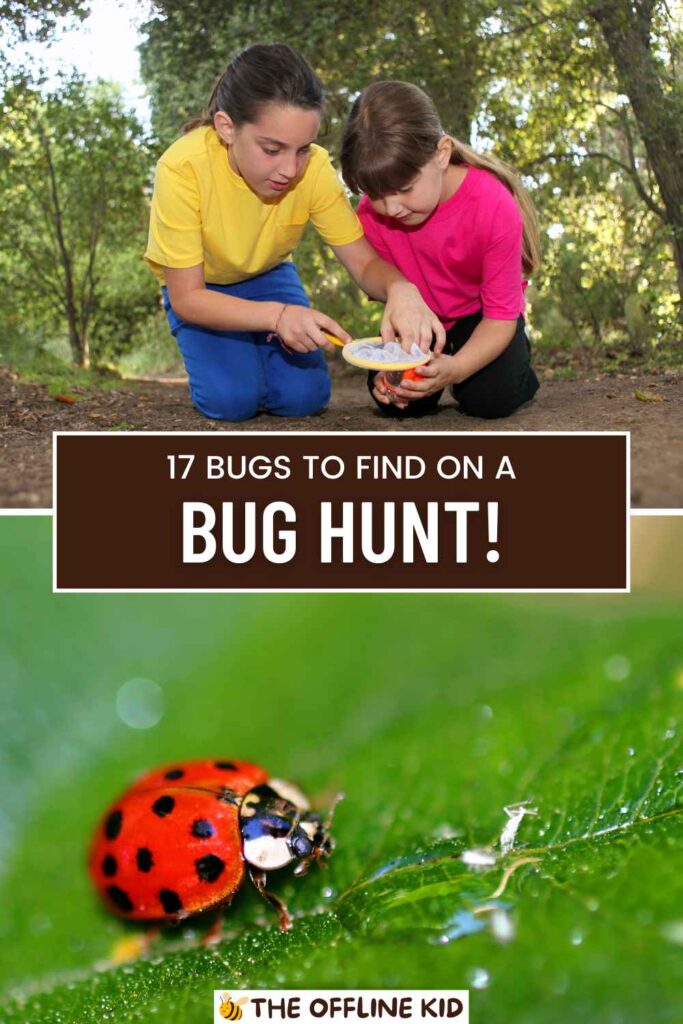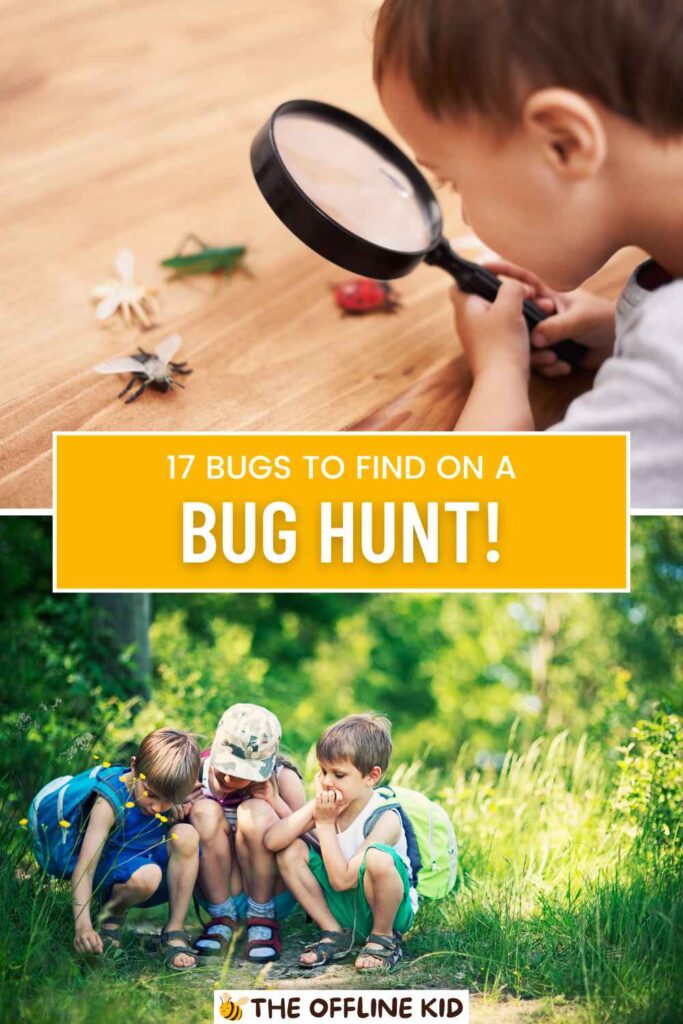Welcome to the ultimate guide to bug hunting!
Explore your yard and discover 17 fascinating bugs with fun facts, safety tips, and exciting activities.
Why Bug Hunting is Beneficial for Kids
Exploring the natural world can be an incredibly enriching experience for children. Bug hunting offers numerous benefits that go beyond simple entertainment.
Here’s why bug hunting is so beneficial for kids:
Educational Benefits
Learning About Ecosystems and Biodiversity
- Understanding Food Chains: By observing bugs, kids can learn about food chains and how different species interact within an ecosystem.
- Biodiversity Appreciation: Recognizing the variety of bugs in their own backyard helps kids appreciate biodiversity and the importance of each species.
Enhancing Observational Skills
- Attention to Detail: Bug hunting requires careful observation, which can enhance a child’s attention to detail and patience.
- Scientific Inquiry: Kids can develop their scientific inquiry skills by asking questions, making hypotheses, and observing bug behavior and habitats.
Physical Benefits
Encouraging Outdoor Activity and Exercise
- Active Exploration: Searching for bugs involves walking, bending, and sometimes climbing, promoting physical activity.
- Sunlight Exposure: Spending time outdoors helps kids get sunlight, which is essential for vitamin D production and overall well-being.
Emotional and Social Benefits
Fostering a Sense of Wonder and Curiosity
- Natural Curiosity: Bug hunting can spark a child’s natural curiosity and lead to a lifelong interest in nature and science.
- Joy of Discovery: Finding and observing bugs can bring a sense of joy and accomplishment.
Opportunities for Family Bonding and Teamwork
- Family Activities: Bug hunting can be a fun family activity, encouraging teamwork and communication.
- Shared Interests: Exploring nature together helps strengthen family bonds and create lasting memories.
To maximize these benefits, it’s important to approach bug hunting with the right mindset.
Encourage curiosity, foster respect for nature, and most importantly, have fun exploring the tiny world beneath your feet!
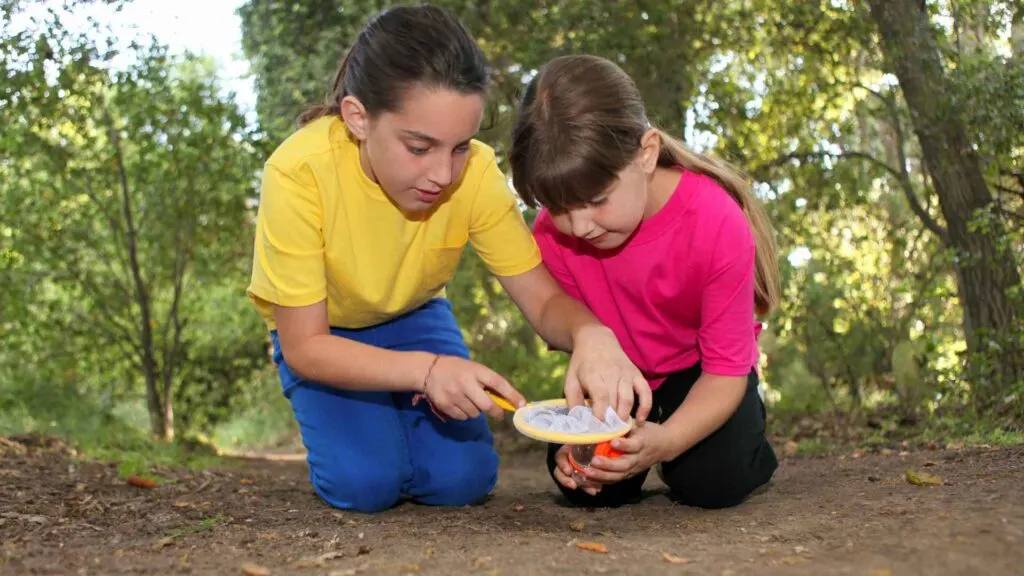
Safety Tips for Bug Hunting
Bug hunting can be a fun and educational activity, but it’s important to prioritize safety to ensure a positive experience for everyone involved. Here are some essential safety tips for bug hunting:
Personal Safety
Wearing Appropriate Clothing and Footwear
- Long Sleeves and Pants: Wearing long sleeves and pants can help protect against bug bites and scratches from plants.
- Sturdy Shoes: Closed-toe shoes or boots provide better protection for feet and help prevent injuries from rough terrain or sharp objects.
Using Insect Repellent
- Effective Repellents: Apply insect repellent to exposed skin and clothing to deter mosquitoes, ticks, and other biting insects.
- Natural Options: Consider using natural repellents like citronella or essential oils if you prefer a chemical-free option.
Environmental Safety
Respecting Wildlife and Habitats
- Gentle Handling: Teach kids to handle bugs gently and with respect. Avoid squeezing or harming them.
- Leave No Trace: Encourage children to leave the environment as they found it. Avoid disturbing nests, webs, or other habitats.
Guidelines for Handling Bugs
- Use Tools Carefully: Use tools like nets and containers carefully to avoid injuring bugs.
- Wash Hands: Remind kids to wash their hands after handling bugs to avoid potential allergic reactions or irritations.
Taking a few simple precautions can help make bug hunting a safe and enjoyable activity for kids. With the right clothing, tools, and respect for nature, you can embark on a fascinating adventure to discover the amazing world of bugs in your backyard!
Essential Bug Hunting Tools
Equipping yourself with the right tools can enhance the bug hunting experience and make it more enjoyable and educational for kids. Here are some essential tools to consider:
Basic Tools
Magnifying Glass
- Closer Look: A magnifying glass allows kids to get a closer look at the intricate details of bugs, enhancing their observation skills.
- Portable: It’s lightweight and easy to carry, making it perfect for outdoor adventures.
Bug Container or Jar with Air Holes
- Temporary Housing: A bug container or jar with air holes provides a safe place to temporarily observe bugs without harming them.
- Transparent: Choose a transparent container so kids can observe the bugs from all angles.
Advanced Tools
Bug Net
- Catching Bugs: A bug net is useful for catching flying insects like butterflies and dragonflies without injuring them.
- Extendable Handle: Look for nets with extendable handles to reach higher places and cover more ground.
Field Guide or Identification App
- Identifying Bugs: A field guide or identification app helps kids learn more about the bugs they find, including their names, habitats, and behaviors.
- Educational Resource: These resources provide detailed information and fun facts, making the bug hunting experience more educational.
Before heading out on a bug hunting adventure, make sure to gather your tools and pack them in a small backpack or tote. Having the right equipment on hand can make the experience smoother and more enjoyable for everyone involved.
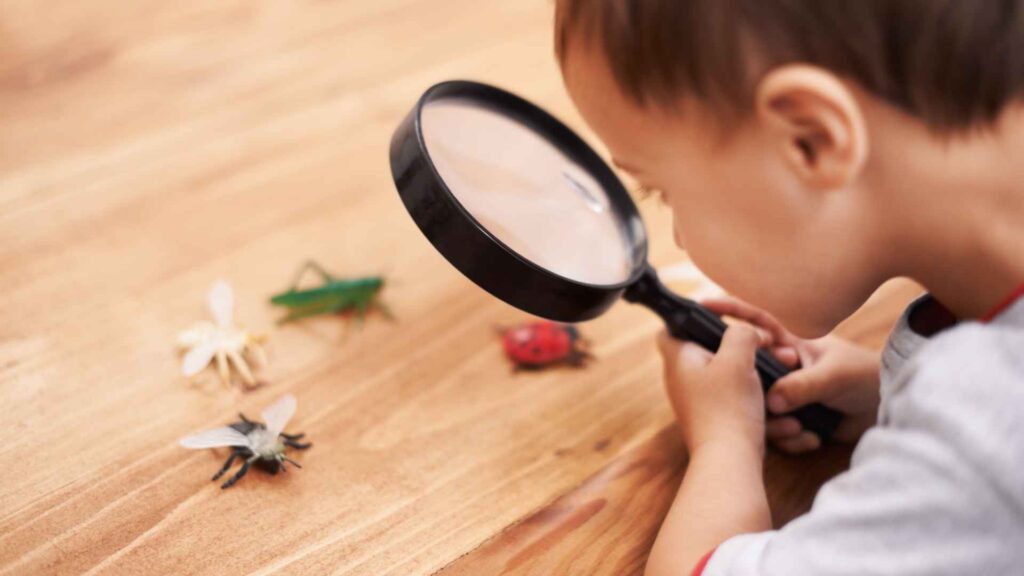
Top 17 Bugs to Find in Your Yard
Your yard is a treasure trove of fascinating insects waiting to be discovered. Here are 17 bugs that kids can find, along with fun facts and interesting information about each one:
1. Ladybugs
Description and Identification
- Appearance: Small, round, usually red or orange with black spots.
- Size: Typically 1/4 inch long.
Fun Facts and Role in the Garden
- Garden Helpers: Ladybugs are beneficial insects that help control aphid populations.
- Defense Mechanism: They can secrete a yellow fluid that deters predators.
2. Butterflies
Common Species to Look For
- Monarchs: Bright orange with black and white markings.
- Swallowtails: Large, often with striking black and yellow patterns.
Life Cycle and Importance as Pollinators
- Transformation: Butterflies go through a complete metamorphosis from caterpillar to chrysalis to adult.
- Pollination: They play a crucial role in pollinating flowers.
3. Beetles
Various Types
- Ground Beetles: Dark, shiny, and often found under rocks.
- June Beetles: Larger, brown or green, and attracted to lights at night.
Interesting Behaviors and Habitats
- Foragers: Many beetles are scavengers that help break down organic matter.
- Diverse Habitats: Beetles can be found in soil, under bark, and among leaf litter.
4. Ants
Different Species and Their Roles
- Carpenter Ants: Large, often found in wood.
- Fire Ants: Red, known for their painful stings.
Ant Colony Structure and Activities
- Social Insects: Ants live in complex colonies with distinct roles (workers, soldiers, queen).
- Communication: They use pheromones to communicate and coordinate activities.
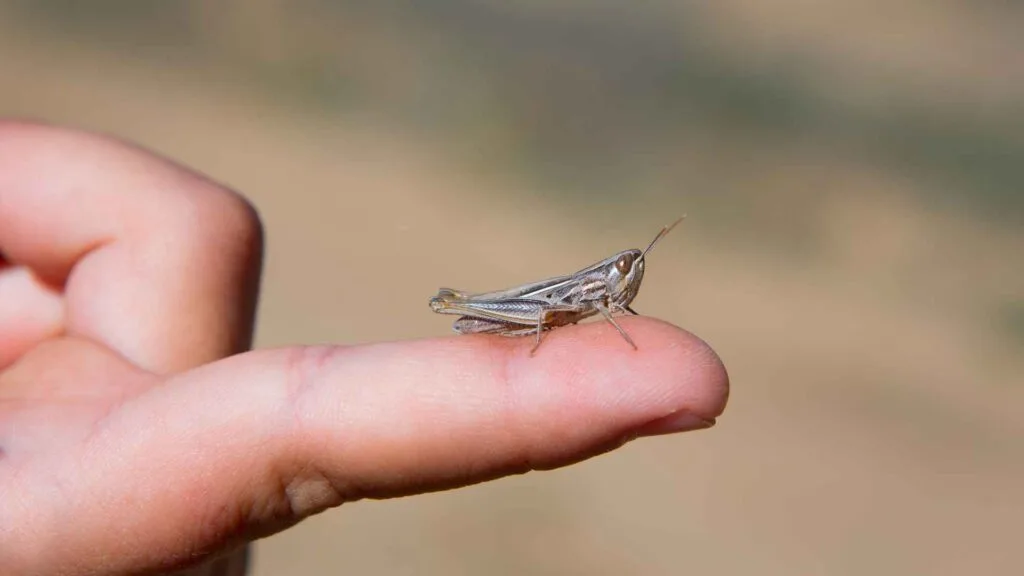
5. Grasshoppers
Identifying Features and Sounds
- Appearance: Long legs for jumping, green or brown bodies.
- Sounds: Males produce chirping sounds by rubbing their wings or legs.
Life Cycle and Diet
- Development: Grasshoppers go through simple metamorphosis (egg, nymph, adult).
- Herbivores: They primarily feed on grasses and plants.
6. Dragonflies
Hunting Habits and Flight Patterns
- Predators: Dragonflies are skilled hunters of smaller insects like mosquitoes.
- Flight: They can fly in all directions, including backward, and hover in place.
Importance in Controlling Mosquito Populations
- Natural Pest Control: Dragonflies help reduce mosquito populations, benefiting humans and animals alike.
7. Crickets
Chirping Sounds and Their Meanings
- Stridulation: Crickets produce chirping sounds by rubbing their wings together.
- Communication: The sounds are used to attract mates and establish territory.
Habitat Preferences
- Where to Find: Often found in grassy areas, under logs, and in basements.
- Nocturnal: Most active at night when they chirp the most.
8. Spiders
Common Types
- Garden Spiders: Large webs, often with a distinctive zigzag pattern.
- Jumping Spiders: Small, colorful, and known for their jumping abilities.
Web-Building and Hunting Techniques
- Web Builders: Many spiders build intricate webs to catch prey.
- Hunters: Some spiders, like jumping spiders, actively hunt and pounce on their prey.
9. Earthworms
Role in Soil Health and Composting
- Decomposers: Earthworms help break down organic matter, enriching the soil.
- Aeration: Their burrowing aerates the soil, improving its structure.
Easy Ways to Find and Observe Them
- Moist Soil: Look under rocks, logs, and in moist soil after rain.
- Compost Piles: Earthworms thrive in compost piles where there is plenty of organic material.
10. Centipedes and Millipedes
Differences Between the Two
- Centipedes: Flat bodies with one pair of legs per segment, fast movers.
- Millipedes: Rounded bodies with two pairs of legs per segment, slower and more docile.
Where to Find Them and Their Diet
- Habitat: Often found under rocks, logs, and in leaf litter.
- Diet: Centipedes are carnivorous, while millipedes primarily feed on decaying plant material.
11. Butterfly Larvae (Caterpillars)
Common Species and Identification
- Monarch Caterpillars: Striped with black, white, and yellow bands.
- Swallowtail Caterpillars: Often green with distinctive markings.
Feeding Habits and Transformation
- Voracious Eaters: Caterpillars eat large amounts of leaves to fuel their transformation.
- Metamorphosis: They eventually pupate and transform into butterflies.
12. Moths
Nocturnal Habits and Species Variety
- Appearance: Generally less colorful than butterflies, with fuzzy bodies.
- Behavior: Most moths are active at night and attracted to light.
Differences Between Moths and Butterflies
- Antennae: Moths have feathery or comb-like antennae, while butterflies have clubbed antennae.
- Resting Position: Moths typically rest with wings open, butterflies with wings closed.
13. Bees
Types of Bees
- Honeybees: Social, live in hives, and produce honey.
- Bumblebees: Larger, fuzzy, and also social but less aggressive.
Pollination and Hive Structure
- Pollinators: Bees are crucial for pollinating plants, which helps produce fruits and vegetables.
- Hive Life: Honeybee hives have a complex social structure with a queen, workers, and drones.
14. Wasps
Differences from Bees
- Appearance: Generally slimmer and less hairy than bees, with more pointed abdomens.
- Behavior: Wasps can be more aggressive and are also important pollinators and predators.
Nesting Habits and Importance in Ecosystems
- Nests: Wasps build nests out of paper-like material, often in sheltered spots.
- Predatory Role: They help control pest populations by feeding on other insects.
15. Pillbugs (Roly-Polies)
Unique Features and Behaviors
- Appearance: Small, grey, segmented, and can roll into a ball for protection.
- Habits: Prefer moist environments and are often found under rocks and logs.
Habitat and Diet
- Detritivores: Pillbugs feed on decaying organic matter, helping to recycle nutrients in the soil.
- Moist Areas: Look for them in damp, dark places like under mulch or leaf litter.
16. Fireflies (Lightning Bugs)
Bioluminescence and Mating Signals
- Light Production: Fireflies produce light through a chemical reaction in their abdomens.
- Communication: The flashing patterns are used to attract mates and communicate with other fireflies.
Where and When to Find Them
- Evening Time: Best seen at dusk and during warm, humid summer nights.
- Habitat: Look for them in grassy areas, near water, and along forest edges.
17. Stink Bugs
Identification and Unique Defense Mechanisms
- Appearance: Shield-shaped bodies, usually brown or green.
- Defense: Release a foul-smelling liquid when threatened to deter predators.
Impact on Plants and Gardens
- Pests: Stink bugs can be pests in gardens, feeding on fruits and vegetables.
- Control: Encourage natural predators or use barriers to protect plants.
Encourage kids to explore their yard and observe these fascinating bugs. Each discovery can be a learning opportunity, sparking curiosity and appreciation for the natural world around them. Happy bug hunting!
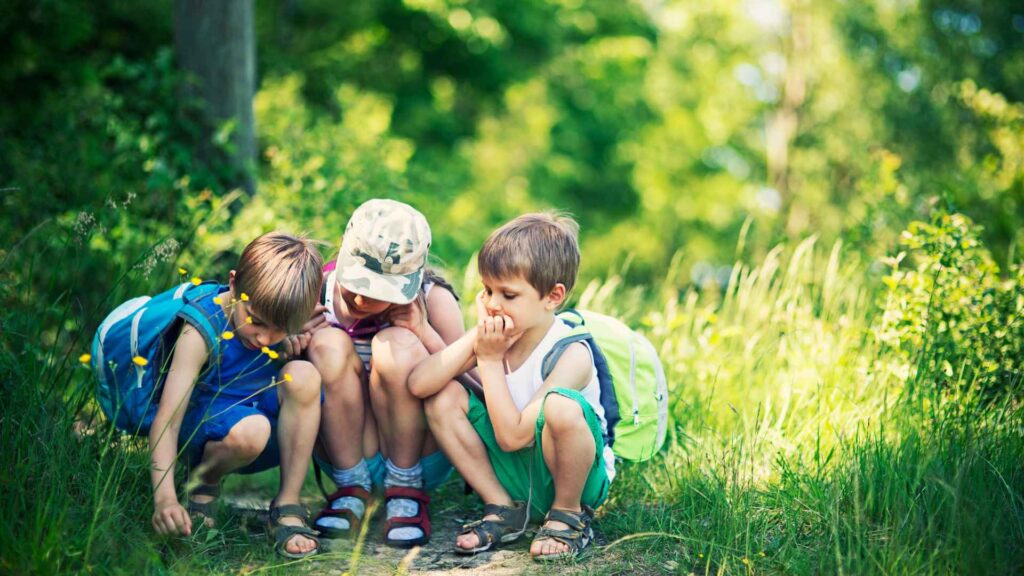
Fun Activities to Do While Bug Hunting
Bug hunting isn’t just about finding and identifying insects; it’s also a great opportunity to engage kids in fun and educational activities.
Here are some creative ideas to make bug hunting even more enjoyable:
Bug Bingo
Creating a Bingo Card
- Preparation: Create a bingo card with pictures or names of common bugs found in your yard.
- Customization: Include a mix of easy-to-find bugs (e.g., ants, ladybugs) and more challenging ones (e.g., dragonflies, fireflies).
How to Play
- Rules: As kids find each bug, they can mark it off on their bingo card. The first to complete a row wins.
- Prizes: Offer small prizes for completing rows or for finding the most bugs.
Bug Journaling
Keeping a Diary of Observations
- Materials: Provide a notebook or journal specifically for bug hunting.
- Entries: Encourage kids to document their findings, including the bug’s name, where it was found, and any interesting behaviors observed.
Drawing and Sketching
- Artistic Expression: Have kids draw pictures of the bugs they find. This helps improve their observation skills and artistic abilities.
- Detailed Sketches: Include details like the bug’s colors, patterns, and body structure.
Bug Hotels
Building Small Habitats
- Materials: Use natural materials like sticks, leaves, and stones to create bug hotels.
- Design: Design the hotel with different sections to attract various bugs, providing hiding spots and shelter.
Observing and Caring for Bugs
- Temporary Residents: Use the bug hotel to observe bugs up close before releasing them back into the wild.
- Learning About Habitats: Teach kids about the different habitats bugs prefer and how to create a welcoming environment.
Bug Races
Organizing Friendly Competitions
- Setup: Choose bugs like beetles or ants and set up a small, safe track for them to race.
- Rules: Place bugs at the starting line and see which one reaches the finish line first.
Learning About Bug Behavior
- Observation: Use the races to observe how different bugs move and behave.
- Discussion: Discuss why some bugs might move faster than others and how their physical features help them.
Nature Crafts
Creating Art from Natural Materials
- Bug-Themed Crafts: Use leaves, twigs, and other natural materials to create bug-inspired art and crafts.
- Educational Projects: Make 3D models of bugs using clay or recycled materials to learn about bug anatomy.
Incorporating Bug Finds
- Specimen Boards: Create specimen boards with pictures and information about the bugs found during hunts.
- Bug Collages: Make collages using images of bugs, leaves, and flowers collected during your adventures.
These activities can make bug hunting a memorable and educational experience for kids.
By incorporating fun games and creative projects, you can turn a simple outdoor activity into a cherished family tradition. Encourage kids to use their imagination and curiosity, and most importantly, enjoy the adventure together!
Learning and Teaching Resources
To enhance the bug hunting experience and make it more educational, there are numerous resources available that can help kids and parents learn more about the insects they find.
Here are some valuable learning and teaching resources:
Books and Field Guides
Recommended Titles for Different Age Groups
- For Younger Kids:
- “The Very Hungry Caterpillar” by Eric Carle: A classic story that introduces the life cycle of a butterfly.
- “Backyard Bugs” by Jill McDonald: A colorful board book that introduces various common bugs.
- For Older Kids:
- “National Geographic Kids Ultimate Bugopedia” by Darlyne Murawski and Nancy Honovich: A comprehensive guide with stunning photos and fascinating facts.
- “Bugged: How Insects Changed History” by Sarah Albee: An engaging book that explores the historical impact of insects.
Using Field Guides
- Identification Help: Field guides are excellent for identifying bugs and learning more about their habitats and behaviors.
- Interactive Features: Look for field guides with interactive elements like QR codes that link to videos or additional online content.
Online Resources
Websites and Apps for Bug Identification
- iNaturalist: A community-based app where users can upload photos of bugs for identification and learn from experts.
- BugGuide.net: A comprehensive website with detailed information and images to help identify bugs found in North America.
Educational Videos and Programs
- YouTube Channels: Channels like “Brave Wilderness” and “SciShow Kids” offer entertaining and educational videos about bugs and other wildlife.
- Online Courses: Websites like Coursera and Khan Academy offer courses and lessons on entomology and ecology.
Local Nature Centers and Programs
Guided Bug Hunts
- Nature Centers: Many local nature centers offer guided bug hunts and educational programs for children and families.
- Workshops and Events: Look for workshops or events focused on insects and nature exploration in your community.
Volunteer Opportunities
- Citizen Science Projects: Participate in citizen science projects like the Monarch Butterfly count or the Firefly Watch program to contribute to scientific research.
- Environmental Groups: Join local environmental groups or clubs that focus on conservation and wildlife, providing additional learning opportunities and hands-on experiences.
These resources can help deepen your child’s understanding and appreciation of the natural world. By incorporating books, online tools, and local programs into your bug hunting adventures, you can create a rich, educational experience that fosters a lifelong love of nature and science.
Conclusion
Bug hunting is a wonderful activity that combines fun, education, and adventure.
By exploring your yard and discovering the fascinating world of insects, kids can learn valuable lessons about nature, develop important skills, and create lasting memories.
